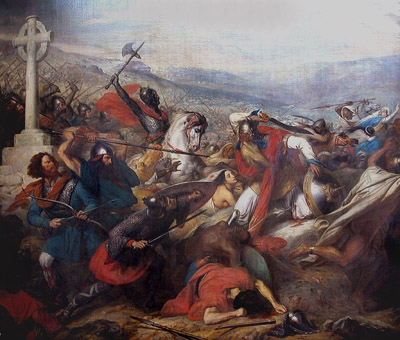October 10, 2007
Gratuitous Historickal Posting (TM)

October 10, 732 A.D. was the final day of the Battle of Tours (or Poitiers) in southwestern France, in which Charles Martel (the "Hammer") and a Frankish army defeated an invading Muslem army led by Abd-er Rahman, governor of Spain. Here is an excerpt from an excellent little account:
From Charles' perspective, the Muslims were not only threatening to damage or destroy the Frankish kingdom's most sacred shrine (and also one of the greatest in all Latin Christendom), but Abd ar-Rahman was challenging the integrity of the regnum Francorum. As major domus of the Merovingian kingdom, and the strongest and most charismatic of its princes in an age when the Merovingian "Long–haired Kings" were said to have become "Do-nothing Kings," it was natural that Charles would be the man to lead the Frankish army in the field against the Muslims.The resulting battle between Charles and 'Abd ar-Rahman is described in a large number of Latin and Arabic sources. Ibn 'Abd al-Hakam refers to the northward extension of 'Abd ar-Rahman's operation into the Frankish kingdom as a separate campaign: 'He then led another military expedition against the Franks." Ibn Abd al-Hakam says: "He went out as a ghazi, and he [and his companions] were martyred for the faith." The greatest medieval Arabic historian, 'Izz ad-Din Ibn al-Athir (1160-1233), writes of the battle in his annalistic history of the world, al-Kamil fi t' Ta'rikh. Like Ibn Abd al-Hakam, Ibn al-Athir writes that 'Abd ar-Rahman went out ghaziyan ("going out as a ghazi") into the land of the Franks.
When one is described as a ghazi in Islamic literature, one can either be engaged in a border war for Islam waged against "infidels," or engaged in simple piratical raids, a continuation of the ancient Bedouin practice of brigandage into the Islamic era. One can imagine that both aspects of the ghazi ethic were present in 'Abd-ar Rahman's army and both Ibn 'Abd al-Hakam and Ibn al-Athir describe 'Abd ar-Rahman as a sincere, just Muslim. Again following Ibn 'Abd al-Hakam, Ibn al-Athir writes that 'Abd ar-Rahman and his companions died in the battle as shuhada'i, "martyrs for the faith."
This idea is reiterated by the thirteenth-century Moroccan author Ibn Idhari al-Marrakushi, who mentioned the battle in his history of the Maghrib, al-Bayan al-Mughrib fi Akhbaral-Maghrib. According to Ibn Idhari, 'Abd ar-Rahman and many of his men found martyrdom on the balat ash-Shuhada'i ("the path of the martyrs). This balat, or "path" was identified by Levi-Provencal and others with the Roman road connecting Poitiers and Tours.
The Franks intercepted the Muslims on this road a short distance from Poitiers, at a site known as Moussais-la-bataille. The details of this encounter, herein called the Battle of Tours/Poitiers, are contained exclusively in Latin sources, as the Arabic sources are silent on the specific events of the battle. The Annals of Aniane and the Chronicle of Moissac contain the same account: Charles and his large army met the Muslims in suburbio Pictavensi ("in the vicinity of Poitiers") and defeated them in a great slaughter, driving the survivors back to al-Andalus. The Chronicle of Fredegar contains a more substantial account of the battle: the Franks killed 'Abd ar-Rahman in the operation and overran the tents of the Muslim camp, presumably to recapture the treasure that had been taken from the Aquitanian churches.
The Mozarabic Chronicle of 754 describes the battle in greater detail than any other Latin or Arabic source: the Franks drew themselves into a large infantry square, so that they were "like an immovable wall" and a "glacier." The Muslims threw themselves at the Frankish square in fruitless attempts to break the formation, and many Muslims were cut down by Frankish swordsmen. The Muslim assault, however, ceased when night fell. The discipline and resolve of the Franks was apparently too much for the Muslims, as Frankish scouts discovered on the following morning that the Muslim camp had been abandoned in haste during the night, with a great deal of plunder having been left behind in the tents.
Read the rest.
Historians seem to disagree about the relative sizes of the two armies and the specific effect of this battle on the Muslim invasion, but it's pretty safe to say that this event represented the high-water mark of Moorish expansionism in southwestern Europe. However, it would be another 750 years or so before the Moors were expelled altogether from Spain. And the Muslim invasion of Europe from the southeast, courtesy of the Ottoman Turks, would not peak until 1685, before the Gates of Vienna.
I can trace my ancestry to Charles through my dad's side of the family, so I have a HUGE version of that Steuben (The original is over twenty square yerds of canvas!). The original is in the Versailles Museum today.
I love romanticised epic battle paintings. It ought to be made into a postcard with an arabic subtitle and dropped en mass in every muslim country.
Posted by: Hucbald at October 10, 2007 02:33 PMNot just historical . . . macrohistorical.
http://en.wikipedia.org/wiki/Battles_of_macrohistorical_importance_involving_invasions_of_Europe
Posted by: The Colossus at October 10, 2007 08:29 PMAbstract paintings
Angel painting
animal paintings
ballet paintings
beach painting
Boat painting
building painting
Children painting
Christ painting
church painting
City painting
Cottage painting
Dancer painting
field painting
Floral paintings
Garden painting
Hunting paintings
impressionist painting
Knight painting
Lady painting
Landscape painting
Lighthouse paintings
Music painting
Nude painting
Oriental paintings
Piano painting
Seascapes paintings
Still Life paintings
street painting
sunset painting
Tropical paintings
Venice paintings
Village painting
wine paintingsalvador dali paintings
thomas kinkade paintings
pablo picasso paintings
vincent van gogh paintings
claude monet paintings
diego rivera paintings


 Image courtesy of the lovely and talented
Image courtesy of the lovely and talented 